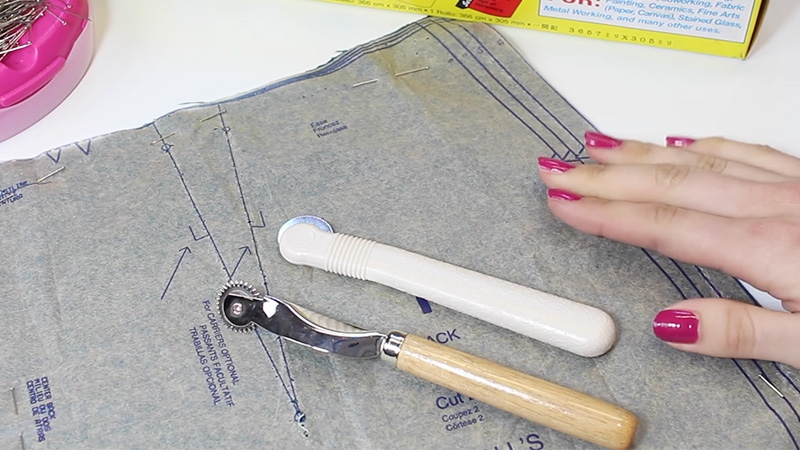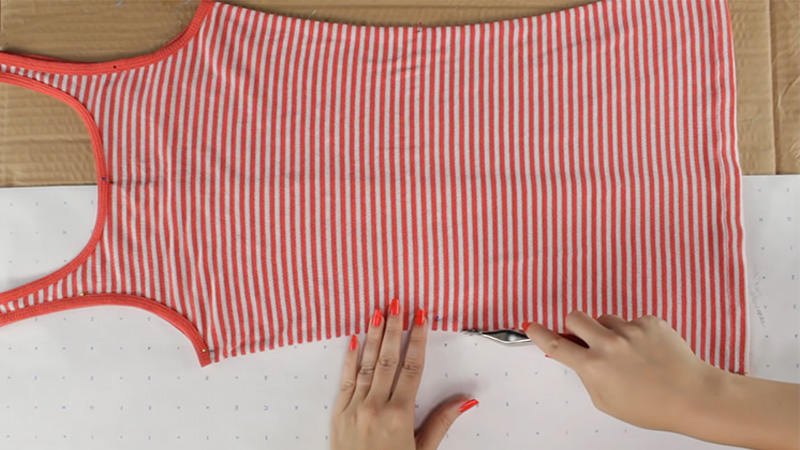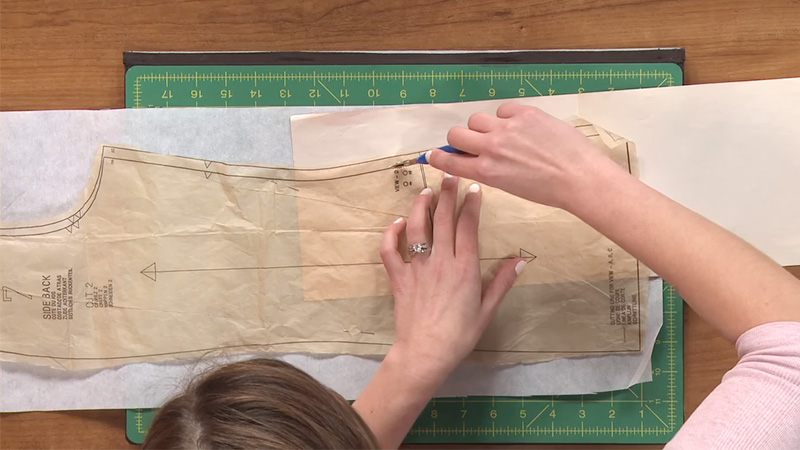Using tracing wheels for sewing is a fundamental technique that empowers sewers and crafters to achieve precision and accuracy in their projects.
A tracing wheel, a small yet indispensable tool, allows for the easy transfer of pattern markings, design elements, and guidelines onto fabric.
Whether you’re a seasoned seamstress or a novice, mastering the art of tracing wheels is essential for creating professional-quality garments, quilts, and crafts.
In this exploration of how to use tracing wheels for sewing, we will delve into various methods and scenarios where tracing wheels prove invaluable.
From marking darts and notches to quilting and appliqué work, understanding the versatility of tracing wheels opens up a world of creative possibilities.
So, let’s embark on this journey to discover the tips, techniques, and tricks that will enhance your sewing and crafting skills.

What Is A Tracing Wheel?
A tracing wheel is a small, hand-held sewing tool designed for transferring markings, patterns, or guidelines onto fabric. It consists of a handle with a wheel at the end, typically made of metal with sharp serrated edges.
When rolled over a paper pattern or template placed on the fabric, the serrated wheel creates a series of tiny perforations that leave marks on the fabric underneath.
Tracing wheels are commonly used in garment sewing, quilting, and various crafts to transfer pattern markings, darts, notches, and other design elements accurately.
They offer precision and convenience, helping sewists and crafters ensure that their projects are sewn or decorated with precision and attention to detail.
Additionally, they come in various wheel sizes and handle designs to suit different needs and preferences in the sewing and crafting community.
How To Use Tracing Wheels For Sewing?
Using tracing wheels in sewing can be a valuable technique for transferring pattern markings and design elements onto fabric accurately.
Here are the simple methods for effectively using tracing wheels:
Marking Darts and Pleats
Place your pattern piece on the fabric, aligning it as needed. Use a tracing wheel along the lines or notches indicating darts or pleats. The serrated wheel will create perforations on the fabric, marking the precise location of these design elements.
Transferring Pattern Markings
Lay your pattern paper with markings on the fabric. Run the tracing wheel over the marked lines. The serrated wheel transfers these markings onto the fabric, ensuring you sew accurately, whether it’s for buttonholes, pockets, or seam allowances.
Notch and Seam Allowance Markings
To mark notches and seam allowances, simply roll the tracing wheel along the paper pattern’s edges where these details are indicated. This process transfers small, easily recognizable marks onto the fabric for alignment during assembly.
Creating Quilt Patterns
When quilting, use a tracing wheel to transfer quilting patterns onto the fabric layers. Lay your quilting template on top of the fabric, and roll the wheel over the design to create a guide for your quilting stitches.
Transferring Embroidery Patterns
For embroidery projects, place your embroidery template on the fabric. Gently trace the design with a tracing wheel to create an outline of the embroidery pattern. This helps you maintain accurate placement and alignment while stitching.
Applying Appliqué Pieces
When working with appliqué, use the tracing wheel to transfer the shape of the appliqué piece onto the base fabric. This ensures that the appliqué is placed precisely where you want it, and you can stitch around the traced outline.
Decorating with Fabric Paints
To create decorative fabric designs, use the tracing wheel to transfer a freehand or stencil design onto the fabric. The perforated lines act as a guide for applying fabric paints, allowing you to achieve intricate and customized patterns.
Always exercise caution when using a tracing wheel to prevent damage to your fabric. It’s advisable to test the wheel on a scrap of fabric first to ensure the markings are as desired.
Tracing wheels come in various sizes and with different serration patterns, so choose one that suits your project and the type of fabric you’re working with.
When To Use A Tracing Wheel?

A tracing wheel is a versatile tool that can be employed in various sewing and crafting scenarios to achieve precise and accurate results.
Here are the occasions when you should consider using a tracing wheel:
Transferring Pattern Markings
Use a tracing wheel to transfer pattern markings such as darts, pleats, notches, and seam allowances from your paper pattern onto the fabric. This ensures that you sew or assemble your garment or project accurately according to the pattern’s design.
Quilting and Appliqué
In quilting, a tracing wheel is handy for transferring quilting patterns or templates onto your fabric layers. It also aids in appliqué work by transferring the shape of the appliqué piece onto the base fabric for precise placement and stitching.
Embroidery Guidelines
When embroidering, use a tracing wheel to outline your embroidery design on the fabric. This creates a guide for your stitches, ensuring that your embroidery work aligns with your intended design.
Creating Fabric Paint Designs
When decorating fabric with paints, a tracing wheel can be used to transfer intricate or freehand designs onto the fabric. The perforated lines act as a template for applying fabric paints, allowing for customized and precise designs.
Buttonhole Placement
Ensure accurate buttonhole placement by marking the locations with a tracing wheel. This ensures that your buttonholes are evenly spaced and aligned for functional and aesthetically pleasing closures.
Pocket Placement
Use a tracing wheel to mark the placement of pockets on garments. This helps maintain consistency and ensures that pockets are positioned correctly on both sides of the garment.
Custom Pattern Alterations
When making custom pattern alterations, a tracing wheel helps you transfer design changes onto the fabric accurately. Whether you’re adjusting the length of a skirt or altering a neckline, the tracing wheel ensures precise alterations.
Knowing when to use a tracing wheel enhances your sewing and crafting projects, allowing you to achieve professional-level precision and detail.
It’s a versatile tool that simplifies the process of transferring patterns, markings, and designs, making your work more efficient and accurate.
Types Of Carbon Transfer Paper For Tracing Wheels For Sewing

Carbon transfer paper for tracing wheels is a valuable tool in sewing and crafting, enabling the easy transfer of patterns, designs, and markings onto fabric or other surfaces.
Here are the types of carbon transfer paper:
Graphite Carbon Transfer Paper
Graphite carbon transfer paper contains graphite as the transfer agent and is ideal for tracing designs onto light to medium-coloured fabrics. It’s often used for embroidery, quilting, and sewing projects.
Wax-Based Carbon Transfer Paper
Wax-based carbon transfer paper is versatile and suitable for various surfaces, including fabric, wood, and paper. It leaves behind wax marks that are easy to remove and works well for crafts and woodworking.
Chalk-Based Carbon Transfer Paper
Chalk-based carbon transfer paper uses chalk as the transfer agent. It’s suitable for darker fabrics and is often used for sewing, embroidery, and fabric painting projects.
Water-Soluble Carbon Transfer Paper
Water-soluble carbon transfer paper dissolves in water, leaving no visible traces behind. It’s perfect for temporary markings on fabric and is commonly used for embroidery and quilting where no permanent markings are desired.
Heat-Sensitive Carbon Transfer Paper
Heat-sensitive carbon transfer paper is designed for use with a hot iron. The markings transfer onto the fabric when heat is applied and can be used for embroidery, fabric painting, and various crafts.
Transfer Film Carbon Paper
Transfer film carbon paper is ideal for precision work, such as transferring intricate embroidery patterns or detailed designs. It leaves clean, sharp lines and is often used in professional embroidery and sewing.
Multi-Color Carbon Transfer Paper:
Multi-color carbon transfer paper comes in various colors, allowing you to transfer designs in different hues. This is useful when you need to trace multiple design elements or color-coded markings for sewing or crafting.
Choosing the right type of carbon transfer paper depends on your project’s requirements, the fabric or surface you’re working with, and whether you need temporary or permanent markings.
These carbon transfer papers make it easier to transfer patterns and designs accurately, making your sewing and crafting endeavors more efficient and precise.
FAQs
What is a tracing wheel, and why is it essential in sewing?
A tracing wheel is a sewing tool featuring a serrated wheel at one end and a handle at the other. It’s crucial for transferring pattern markings, darts, notches, and other design elements from paper patterns to fabric, ensuring precision and accuracy in sewing projects.
How do I use a tracing wheel for transferring pattern markings?
To use a tracing wheel, place your paper pattern on the fabric, aligning it as needed. Roll the tracing wheel over the pattern markings with firm but gentle pressure.
The serrated wheel creates perforations on the fabric, transferring the markings.
Can I use a tracing wheel on delicate or lightweight fabrics?
Yes, you can use a tracing wheel on delicate fabrics, but exercise caution. Place a piece of tissue paper or lightweight stabilizer between the fabric and the pattern to prevent damage or distortion while transferring markings.
Are there different types of tracing wheels for specific projects?
Yes, tracing wheels come in various types, including serrated, smooth, and dual-wheeled options. Each type is suitable for different applications, such as transferring patterns, quilting, or delicate fabrics.
How do I remove tracing wheel marks from fabric if they’re no longer needed?
Tracing wheel marks are often temporary and can fade over time. To expedite removal, gently rub the fabric or wash it according to the fabric’s care instructions.
Water-soluble carbon transfer paper markings can be removed with water. Always test on a scrap of fabric first to avoid damaging your project.
Conclusion
In the world of sewing and crafting, the utilization of tracing wheels is a testament to precision and meticulousness. These unassuming tools allow for the accurate transfer of vital information from patterns and templates to fabric, resulting in perfectly aligned seams, precisely placed embellishments, and intricate embroidery.
As we conclude our exploration of how to use tracing wheels for sewing, it becomes evident that these tools are indispensable in the pursuit of flawless creations. Whether you’re a quilter, an embroiderer, or a garment maker, tracing wheels offer a way to ensure your projects meet the highest standards of craftsmanship.
So, as you embark on your sewing adventures, remember that the humble tracing wheel can be your key to achieving sewing perfection and taking your creative endeavors to new heights.
Leave a Reply